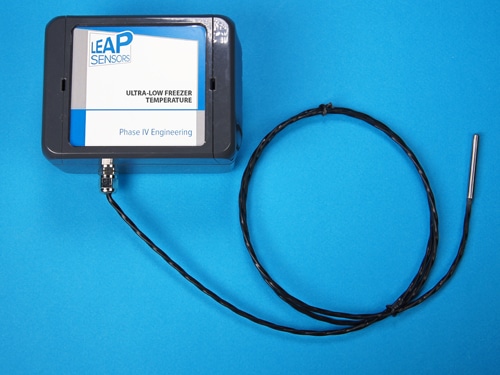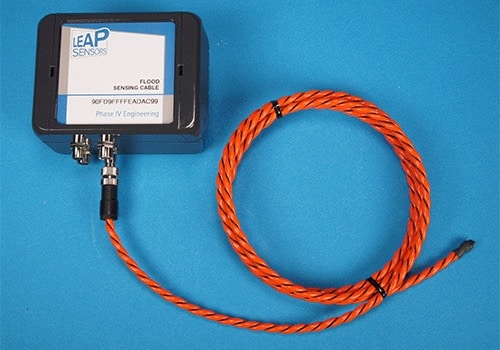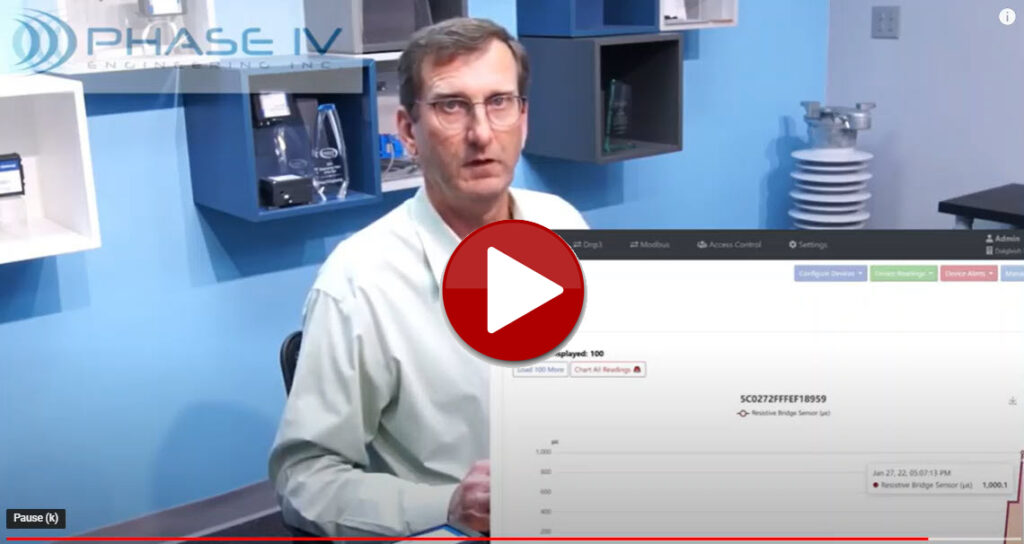- High accuracy RTD sensing at ultra low temperatures - as low as -196ºC (-320ºF).
- Temperature probe is verified and calibrated at 3 points: -60ºC, -40ºC, and +5ºC (-76ºF, -40ºF, and +41ºF)
- Optional industrial door-open sensor helps troubleshoot temperature alerts, as well as tracking each time the door is opened. Time that door is left open is reported - and alarms can be set on excessive door-open time.
- Optional wall transformer powers the sensor and also alerts power outages. On-board battery backup assures sensor node operation during power outages.
-
 Integrate any sensor with an RS485, RS485 Modbus, or RS232 output into the Leap Sensors system to convert it to a wireless sensor. The sensor is powered by the battery in the Leap transceiver node with a power supply that can be specified from 3.6V to 24 volts. No external power source is needed. Contact us to let us help you make your selected RS485 or RS232 sensor wireless. Part of the breakthrough Leap Sensors® system. Build your quote here:
Integrate any sensor with an RS485, RS485 Modbus, or RS232 output into the Leap Sensors system to convert it to a wireless sensor. The sensor is powered by the battery in the Leap transceiver node with a power supply that can be specified from 3.6V to 24 volts. No external power source is needed. Contact us to let us help you make your selected RS485 or RS232 sensor wireless. Part of the breakthrough Leap Sensors® system. Build your quote here: -
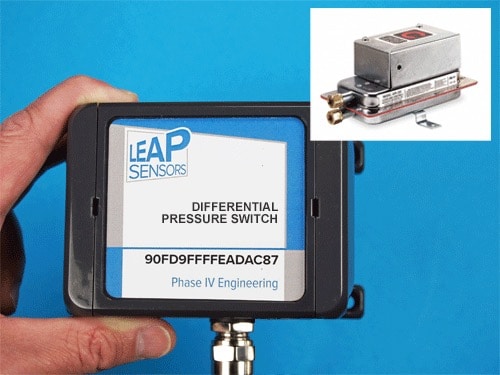 The Leap wireless pressure transceiver can integrate with every type differential pressure switch with a "dry contact" switch output. The differential pressure switch featured with this product is a Cleveland Controls Air Sensing Switch, HVAC/General Purpose Type, 0.02 to 0.8 Differential (In. WC). Contact us to find the best combination or let us know which pressure switch you would like us to integrate. Part of the breakthrough Leap Sensors® system. Build your quote here:
The Leap wireless pressure transceiver can integrate with every type differential pressure switch with a "dry contact" switch output. The differential pressure switch featured with this product is a Cleveland Controls Air Sensing Switch, HVAC/General Purpose Type, 0.02 to 0.8 Differential (In. WC). Contact us to find the best combination or let us know which pressure switch you would like us to integrate. Part of the breakthrough Leap Sensors® system. Build your quote here: -
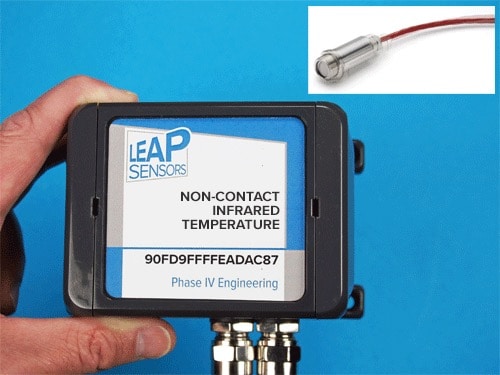 Ideal for monitoring temperature with a non-contact IR sensor. Standard model measures temperatures from -20C to 1000C with a 20:1 field of view. Contact us if you need an application specific wireless sensor with different specifications. Part of the breakthrough Leap Sensors® system. Build your quote here:
Ideal for monitoring temperature with a non-contact IR sensor. Standard model measures temperatures from -20C to 1000C with a 20:1 field of view. Contact us if you need an application specific wireless sensor with different specifications. Part of the breakthrough Leap Sensors® system. Build your quote here: -
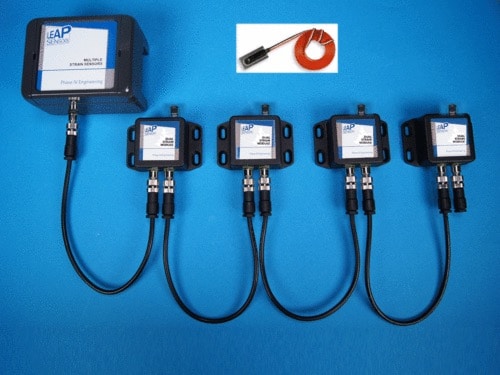 Breakthrough technology uses CAN bus to "daisy chain" multiple small strain gauge sensor modules to one wireless Leap transceiver node. Anywhere from 1 to 16 strain gauge modules can be added to the bus. Each CAN strain module can support 2 full-bridge resistive strain gauge sensors, for a total of up to 32 full-bridge strain gauges per transceiver node. Edge processing at the strain sensor level assures a high-quality conversion of the sensor voltage reading to a digital reading, which can then be reliably sent via the CAN bus to the wireless transceiver node. Industrial CAN bus cables can be over 600 feet long. Ideal for wireless monitoring of strain in multiple points along structural components such as I-beams, girders, hanging structures, support columns, railways etc., as well as industrial applications such as rotating shafts in engines, turbines, etc.
Breakthrough technology uses CAN bus to "daisy chain" multiple small strain gauge sensor modules to one wireless Leap transceiver node. Anywhere from 1 to 16 strain gauge modules can be added to the bus. Each CAN strain module can support 2 full-bridge resistive strain gauge sensors, for a total of up to 32 full-bridge strain gauges per transceiver node. Edge processing at the strain sensor level assures a high-quality conversion of the sensor voltage reading to a digital reading, which can then be reliably sent via the CAN bus to the wireless transceiver node. Industrial CAN bus cables can be over 600 feet long. Ideal for wireless monitoring of strain in multiple points along structural components such as I-beams, girders, hanging structures, support columns, railways etc., as well as industrial applications such as rotating shafts in engines, turbines, etc.Wireless Strain Demonstration and Tutorial
Contact us to find the best strain sensor configuration for your specific application. Part of the breakthrough Leap Sensors® system. Multiple strain sensing modules attach to the transceiver node over a CAN bus. Each module can support two full-bridge strain sensors. The strain modules are ordered separately. Contact Us and an Application Engineer will work with you to provide a detailed final quote that meets your specific application. Build your quote here: -
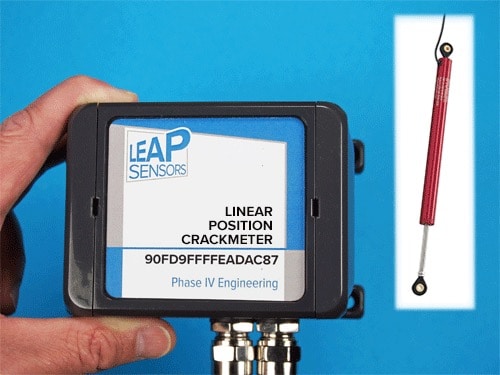 Sensor transceiver node designed to integrate with a wide range of linear position sensors and crack monitors with common outputs such as 0-5V, 4-20 mA, and RS485. The crack monitor is powered from the battery in the Leap transceiver node. When combined with a wireless transmitter, these sensors are very effective at monitoring changes in cracks or other movement over time in remote locations. Part of the breakthrough Leap Sensors® system. The linear sensor that meets your specific requirements will be integrated and tested with this device node. Contact us to find the best linear position configuration for your specific application. This external linear crack sensor is not included in this price but will be included in a final quote. Build your quote here:
Sensor transceiver node designed to integrate with a wide range of linear position sensors and crack monitors with common outputs such as 0-5V, 4-20 mA, and RS485. The crack monitor is powered from the battery in the Leap transceiver node. When combined with a wireless transmitter, these sensors are very effective at monitoring changes in cracks or other movement over time in remote locations. Part of the breakthrough Leap Sensors® system. The linear sensor that meets your specific requirements will be integrated and tested with this device node. Contact us to find the best linear position configuration for your specific application. This external linear crack sensor is not included in this price but will be included in a final quote. Build your quote here: -
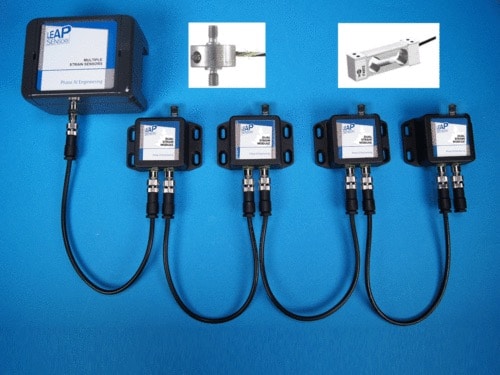 Breakthrough technology uses CAN bus to "daisy chain" multiple load cell interface modules to one wireless Leap transceiver node. Anywhere from 2 to 30 load cell modules can be added to the bus. Each load cell module can support 2 full-bridge mV/V load cells, for a total of up to 60 load cells per transceiver node. Edge processing at the strain sensor level assures a high-quality conversion of the sensor voltage reading to a digital reading, which can then be reliably sent via the CAN bus to the wireless transceiver node. Industrial CAN bus cables can be over 600 feet long. Ideal for wireless monitoring loads and force in several places along structural components such as I-beams, girders, support columns, etc. Contact us to find the best strain sensor configuration for your specific application. Part of the breakthrough Leap Sensors® system. Contact us for pricing on your specific configuration. Build your quote here:
Breakthrough technology uses CAN bus to "daisy chain" multiple load cell interface modules to one wireless Leap transceiver node. Anywhere from 2 to 30 load cell modules can be added to the bus. Each load cell module can support 2 full-bridge mV/V load cells, for a total of up to 60 load cells per transceiver node. Edge processing at the strain sensor level assures a high-quality conversion of the sensor voltage reading to a digital reading, which can then be reliably sent via the CAN bus to the wireless transceiver node. Industrial CAN bus cables can be over 600 feet long. Ideal for wireless monitoring loads and force in several places along structural components such as I-beams, girders, support columns, etc. Contact us to find the best strain sensor configuration for your specific application. Part of the breakthrough Leap Sensors® system. Contact us for pricing on your specific configuration. Build your quote here: -
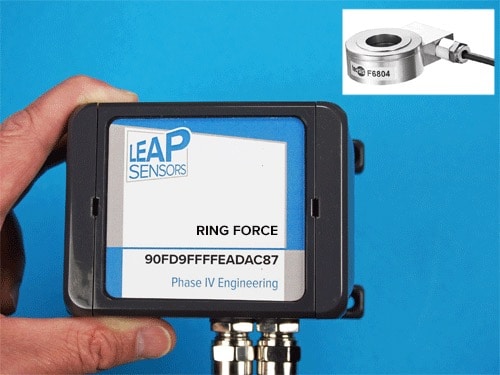 Wireless transceiver node designed to integrate with any ring force transducer that has one of these outputs: mV/V, 4-20 mA, or 0-10V. The Leap transceiver node provides power to the ring force transducer. Ideal for monitoring preloads, testing equipment, clamping forces, and remote ongoing force and load monitoring. Contact us to find the best ring force transducer configuration for your specific application. Part of the breakthrough Leap Sensors® system. Build your quote here:
Wireless transceiver node designed to integrate with any ring force transducer that has one of these outputs: mV/V, 4-20 mA, or 0-10V. The Leap transceiver node provides power to the ring force transducer. Ideal for monitoring preloads, testing equipment, clamping forces, and remote ongoing force and load monitoring. Contact us to find the best ring force transducer configuration for your specific application. Part of the breakthrough Leap Sensors® system. Build your quote here: -
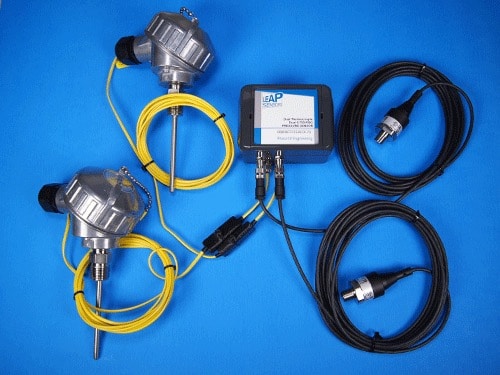 This Leap wireless transceiver node integrates two standard industrial pressure sensors along with two thermocouples. (Type K is standard, but other types can also be integrated). The sensor is powered by the Leap Sensor device battery with a power supply that can be specified - 12 or 24 volts. No external power source is needed. Contact us to let us help you make your selected pressure sensors and thermocouples wireless. Part of the breakthrough Leap Sensors® system. Build your quote here: Contact us for pricing for your unique configuration.
This Leap wireless transceiver node integrates two standard industrial pressure sensors along with two thermocouples. (Type K is standard, but other types can also be integrated). The sensor is powered by the Leap Sensor device battery with a power supply that can be specified - 12 or 24 volts. No external power source is needed. Contact us to let us help you make your selected pressure sensors and thermocouples wireless. Part of the breakthrough Leap Sensors® system. Build your quote here: Contact us for pricing for your unique configuration. -
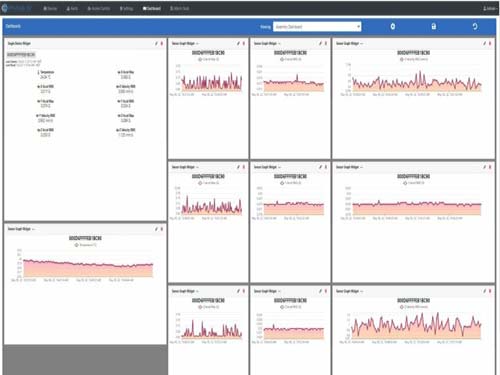 Put all of your most important sensor data and graphs on one page with the Dashboard option in the Leap software. Dashboards can be configured for you by the Phase IV Engineering team - or select the option to configure your own dashboards.Contact us for pricing on your specific requirements.Contact Us
Put all of your most important sensor data and graphs on one page with the Dashboard option in the Leap software. Dashboards can be configured for you by the Phase IV Engineering team - or select the option to configure your own dashboards.Contact us for pricing on your specific requirements.Contact UsPrices, Quotes, Questions...
Need a price or a quote? Have questions? Want to talk to an expert? Need a custom solution?Contact Us -
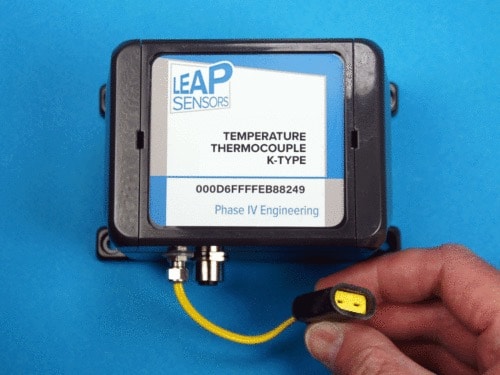
Coming Soon
This Leap wireless sensor has eight standard mini thermocouple connectors that can connect to any type of thermocouple (type K is standard). Because thermocouples can be used over a wide temperature range and thermocouples come in a huge range of probe types, this sensor addresses many harsh industrial applications.
